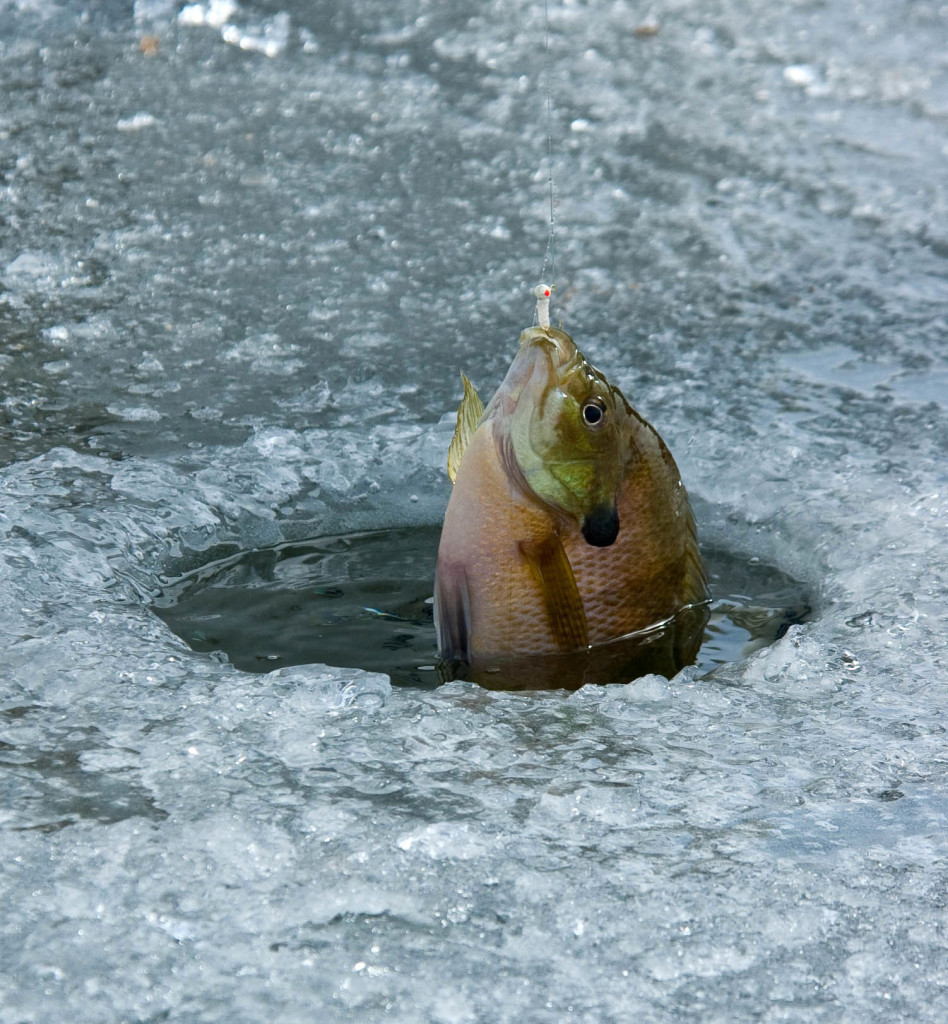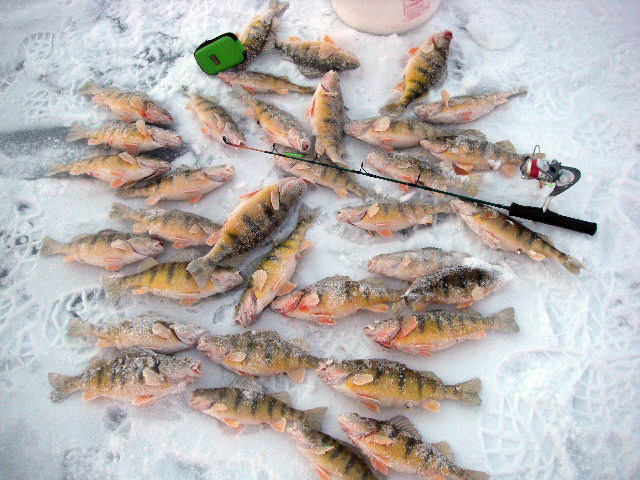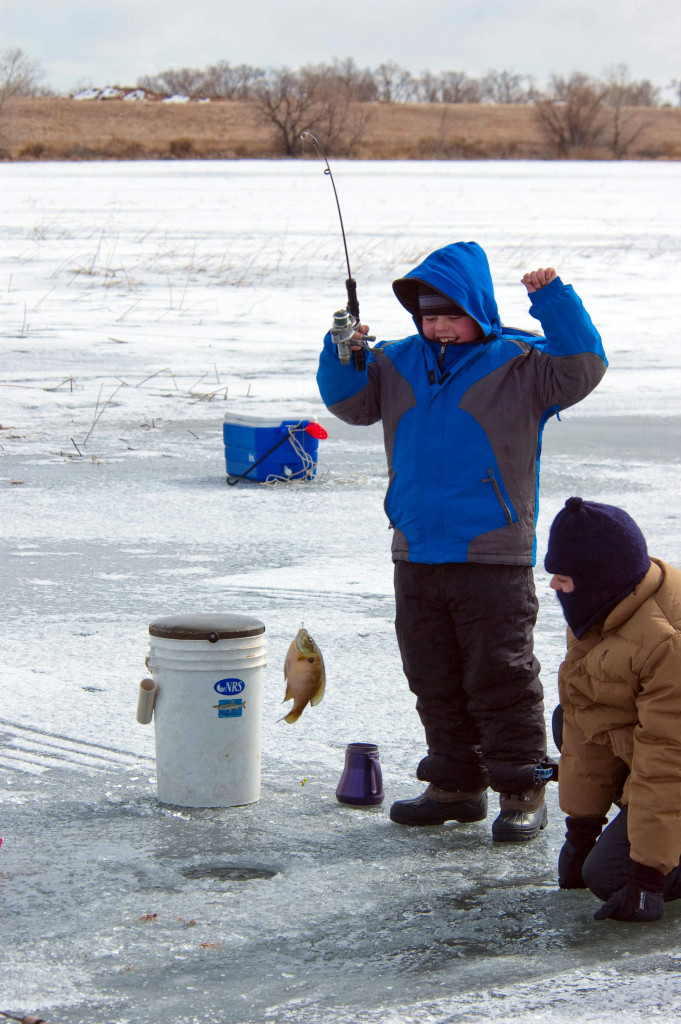
ST. GEORGE — Putting your bait or lure at the depth where the fish are is the key to catching fish through the ice. Using simple devices can help you know when you have a fish on your line.
Drew Cushing, warm water sport fisheries coordinator for the Division of Wildlife Resources, said fish become lethargic when they’re under the ice.
“Fish will often stay at a certain water depth all winter long,” Cushing said. “Also, they aren’t able to move as fast to catch their food. Keep those two things in mind, and you should find plenty of fish on the end of your line this winter.”
You can stay updated on where fishing is best in Utah at Utah Division of Wildlife Resources, Big Fish Tackle and Utah Wildlife Network. You can also learn more about the basics of ice fishing by watching a video titled “Ice Fishing Basics, Jan. 8, 2015,” which shows a clinic held in Salt Lake City.

Southern Utah highlights
In Southern Utah – basically south of Spanish Fork – the DWR fishing reports hot spots Web page shows only Lake Powell rated with good fishing, although no ice is indicated there. Likely catches are smallmouth bass, striped bass, walleye, largemouth bass, crappie, channel catfish.
There are a number of waters in the south, however, that the DWR indicates are offering fair fishing at this time.
Otter Creek Reservoir capped with ice just after Thanksgiving, the DWR reports, but it has thawed and refrozen since. There are 4-5 inches of ice, it states, but cautions people to stay clear of any open water or cracks. Fishing is slow to fair for some nice-sized rainbows.
Duck Creek Pond and Aspen Mirror Lake have plenty of open water, currently, with some thin office. Likely catches are brook trout and rainbow trout. Nearby Navajo Lake has 8 inches of ice, but access to the lake is limited by snow. Fishing is fair to good for splake in the early morning.
Panguitch Lake is sporting 7-8 inches of ice snow on top, the DWR reports, noting slush can get pretty bad. Fishing is slow to fair in shallow water, and better in depths of 20 to 30 feet. You can find fish from the surface to the bottom, it reports and suggests using small, light-colored jigs tipped with nightcrawler, meal worm, shrimp or pieces of frozen minnows.
Upper Enterprise Reservoir is iced over but the DWR classifies the ice unstable. Newcastle Reservoir has 2 inches of ice with open water between the boat ramp and dam and likely catches will be rainbow trout, smallmouth bass and wiper.

Baker Reservoir may experience some thin ice during cold snaps but more typically has open water throughout the winter, according to the DWR. Fishing there is currently rated fair with catchable-sized rainbow trout stocked and some large brown trout present.
Gunlock Reservoir has been treated with rotenone to deal with illegally introduced smallmouth bass that pose a serious threat to native fish in the Virgin and Santa Clara rivers. Although the reservoir will be restocked in 2016 with largemouth bass, bluegill and crappie, the DWR states that fishing opportunities will be limited for the next two or three years while these fish establish.
Kolob Reservoir should be iced over, but DWR does not have any recent reports on ice thickness. Access to Kolob may be limited depending on snow through the winter and the reservoir is closed to bait fishing until May 2016 – St. George News reported in December 2015 the Kolob Terrace Road snow packed and not maintained in the winter, with cautions from Washington County Sheriff against using it.
There are a number of community fisheries in Washington County and Iron County with fishing currently rated fair.
While fishing is fair at Quail Creek Reservoir, bass activity slows down at Sand Hollow Reservoir when the weather is cold, the DWR reports, but anglers still catch a few nice-sized fish during the colder months. Fish deep (in 20 to 30 feet of water) and use a slow presentation. Finesse baits like Senkos, drop-shot rigs and shaky heads work well with a slow presentation. Slow-rolling spinnerbaits can also be very effective.
See locations and particulars for additional waters throughout Utah at the Division of Wildlife Resources Fishing Reports hot spots map linked here.
Techniques
Cushing recommends two techniques to help you find and catch fish.
The first technique is simple: Drop your bait to the depth where you think the fish are and let it sit. Keep it still. If you’ve put your lure or bait near a fish, there’s a good chance the fish will take it.
Sometimes, though, it’s challenging to know if a fish has your bait in its mouth.

“Fish are extremely passive in the winter,” Cushing said. “They can have your bait or lure in their mouth and you won’t even know it.”
For that reason, Cushing recommends lifting your rod occasionally.
“If a fish has your bait or lure in its mouth,” he said, “as soon as you raise your rod, you’ll set the hook.”
If you lift your rod and a fish isn’t there, let your bait flutter down to its starting point and watch it for awhile before lifting it again.
The second technique is called “lift, drop and hold.” Drop your bait to the depth where you think the fish are. Using your wrist, lift the bait about six inches and let it flutter back down to the starting point. Once the bait reaches the starting point, sit for a few seconds and then lift it again.
Cushing said fish will watch the bait as it moves and take it when it stops moving.
Water depth
The depth at which you’ll find fish varies depending on the species you’re after. No matter where you’re fishing in Utah, you’ll probably find fish at the following depths:
Yellow perch
Either on the bottom of the water you’re fishing or no more than six inches above the bottom.

Bluegill, largemouth bass
Near brush, bulrushes, rocks and weeds. Look for vegetation sticking up through the ice or ridges that extend into the water. Start by dropping your bait all the way to the bottom of the water. Then raise your bait 6-12 inches at a time. Keeping raising until you find the fish.
Trout, kokanee salmon
Suspended at various depths. Trout and salmon can be found from just under the ice to 15 feet below the ice.
“Once you find the depth at which trout or salmon are suspended in a body of water,” Cushing said, “there’s a good chance you’ll find them at that depth throughout the winter.”
To catch trout and salmon, Cushing recommends fishing just under the surface. If you don’t get a bite, lower your bait a few feet. Try that depth for awhile. If the fish still aren’t biting, continue lowering your bait a few feet at a time. If you’re using the right bait and you’re still not catching fish, trout and salmon are not in that part of the lake.
Splake
Close to the bottom.

Burbot, walleye, tiger muskie, Northern pike
Near the bottom of the water you’re fishing. These fish like to pick baits up, swim with them and then eat what they’ve picked up. Fishing with the bail on your reel open or using a tip up are good ways to let the fish run with your bait before you set the hook.
Also, if you’re fishing for burbot, walleye, tiger muskie or Northern pike, use dead fish as bait. Cut pieces of carp, chub or fish that you buy from a store are perfect for your hook.
“All four of these species are very attracted to fish meat,” Cushing said. “It’s excellent bait to use.”
If you’re not sure which depth to try, ask others who are catching fish near you.
“Most anglers are very willing to tell you the depth at which they’re catching fish,” Cushing said.
Cushing also reminds you that fish aren’t everywhere in a lake. If you fish for 30 minutes without getting a bite, move to a new spot.
“Once you find a spot that has fish,” he said, “keep coming back. More often than not, an ice fishing hot spot will stay hot through the winter.”

Bobbers
Not only do fish move less under the ice, they bite less aggressively, which makes it challenging to know when a fish is striking your bait.
“If you’re relying on your fishing rod to tell you when a fish is on the end of your line,” Cushing said, “you might not know when it’s time to set the hook.”
Fortunately, two inexpensive items — spring bobbers and slip bobbers — can help you detect the subtle bites.
Spring bobbers attach to the end of your fishing rod. After attaching the bobber, run your fishing line through it and attach your hook. After lowering your hook to the desired depth, watch the spring bobber closely. Spring bobbers are extremely sensitive. They’ll detect bites long before your fishing rod begins to flex.
Slip bobbers are another way to detect soft bites. Slip bobbers come in various designs, but most have a hole that runs through the middle of the bobber.
To fish with a slip bobber, start by placing or tying a bobber stop on your line. Tie or place the stop at the distance you want your hook to suspend. If you want your hook to suspend 10 feet below the surface of the water, pull out 10 feet of line and tie your bobber stop 10 feet from the end of your fishing line. Next, run your fishing line through the bobber. Finally, tie your hook to the end of the line.
After you’re set up, reel your fishing line in until the bobber comes to the end of your fishing pole. When you want to fish, simply release the bail on your reel. The baited hook will pull line through the bobber until the bobber stop contacts the bobber and stops the hook from falling. The bobber will sit on top of the water with your line dangling under it.

“When you see the bobber move,” Cushing said, “you’ll know it’s time to raise your fishing rod and set the hook.”
Tip ups
A tip up will cost you about $15 and is effective and fun to use. It takes the place of your fishing rod.
When a fish takes your bait, a mechanism on the tip up sends a small flag up, alerting you.
“Using a tip up makes it easier to fish in two holes,” Cushing said. “You can drill two holes a ways apart and still know when a fish is biting in either hole.”
Remember that your poles or tip ups cannot be more than 100 feet apart. You must be able to see each pole or tip up clearly.
Email: [email protected]
Twitter: @STGnews